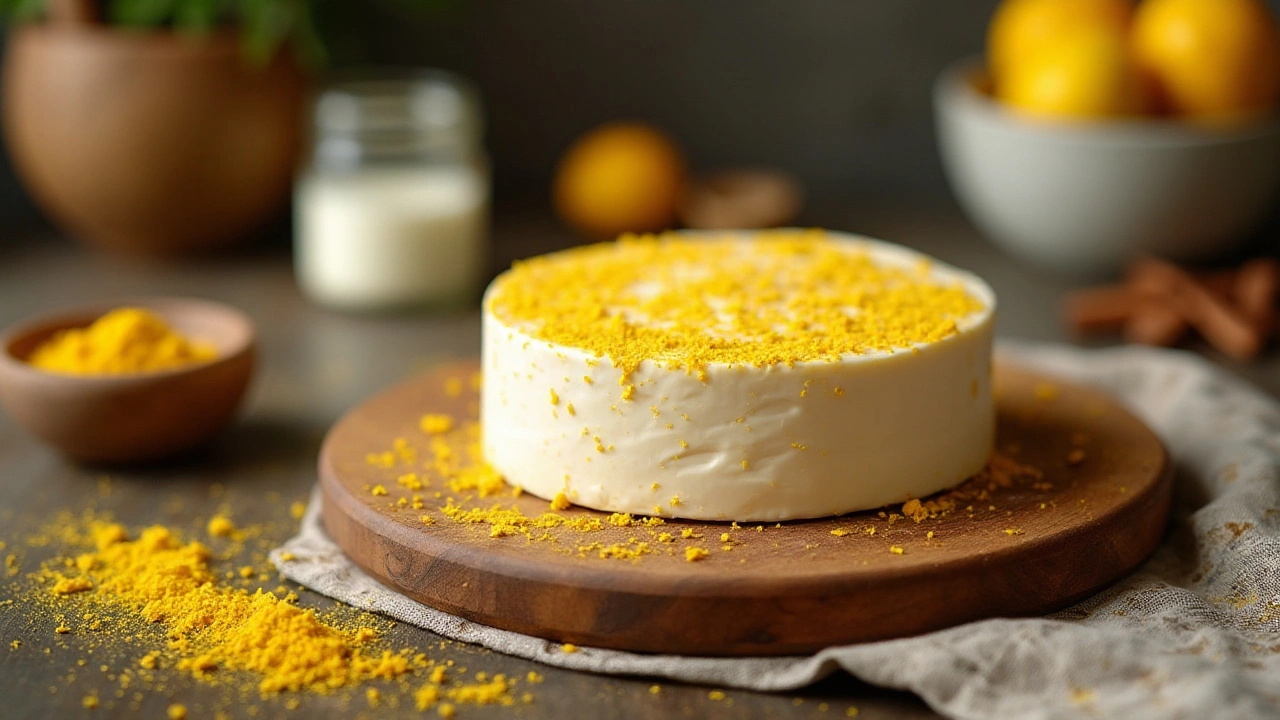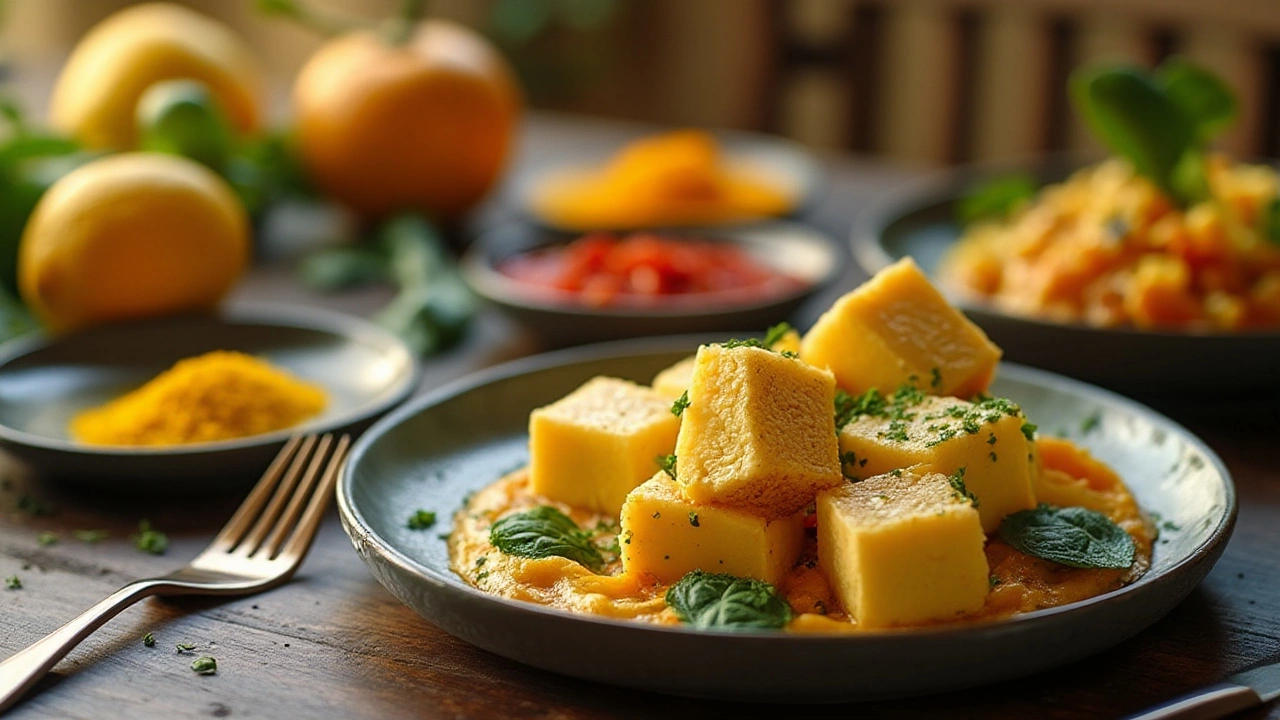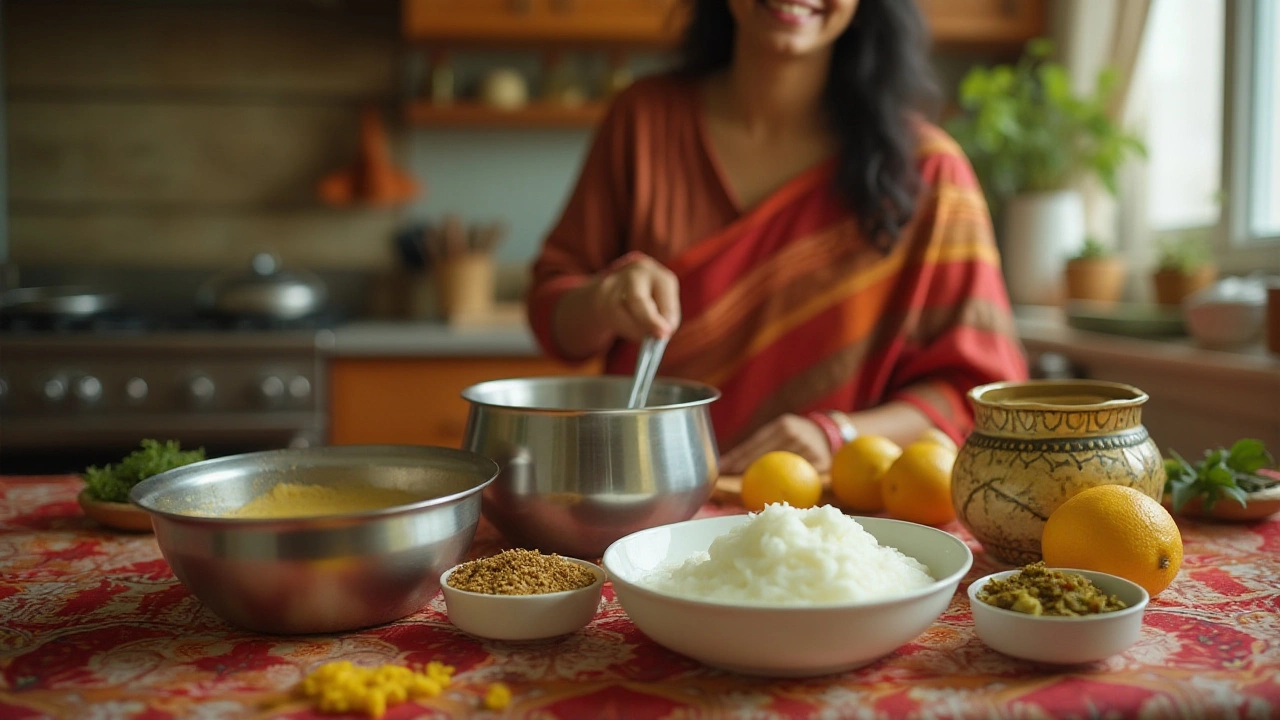There's nothing quite like the satisfaction of making your own paneer at home. It's simple, fresh, and full of possibilities. But what if you want to infuse it with a tangy lemon flavor without using any lemons? Whether you're out of fresh lemons or prefer a slightly different touch, achieving that crisp citrus taste is entirely possible.
This guide is all about exploring alternatives to traditional lemon juice, ensuring your homemade paneer retains the desired zestiness. From using vinegar and citric acid to experimenting with flavor enhancers, we’ll take a closer look at the methods to elevate your cheese game. Join me on this flavorful journey as we dive into the world of homemade paneer with a twist!
- Understanding Paneer and Its Flavor Profile
- Alternatives to Lemon in Paneer Making
- Step-by-Step Guide to Mimicking Lemon Flavor
- Enhancing Your Culinary Creations with Paneer
- Troubleshooting Common Issues in Paneer Making
Understanding Paneer and Its Flavor Profile
The marvel of homemade paneer lies in its simple, yet magical transformation. Paneer, often referred to as Indian cottage cheese, is cherished for its soft, crumbly texture and its mild, versatile taste. It serves as a blank canvas for an array of flavors, capable of absorbing spices and enhancers beautifully. The process of making paneer dates back centuries, and it’s an integral part of many traditional Indian dishes. The basic ingredients include milk, followed by an acid such as lemon juice, vinegar, or citric acid to curdle it. Once the milk separates into curds and whey, the curds are pressed to remove excess moisture, resulting in a block of fresh paneer ready to be sliced, diced, or crumbled.
What sets paneer apart from many other cheeses is the absence of salt and its fresh, pure aroma. This neutral baseline allows it to pair well with both sweet and savory dishes. The subtlety of paneer’s flavor makes it a popular choice not only in curries and snacks but also in desserts. Adding a touch of lemon flavor to paneer can transform its taste profile by introducing a refreshing tanginess that can elevate dishes to a gourmet level. Whether you choose to serve it grilled, fried, or smothered in a rich sauce, paneer offers unparalleled versatility.
"Paneer is an essential part of our culinary heritage, seamlessly blending with myriad flavors while enhancing the dish's overall appeal." - Tarla Dalal, Celebrated Indian chef and cookbook author.
Understanding the flavor profile of paneer is crucial in unlocking its potential in the kitchen. Its adaptability stems from its unique composition, which lacks the fermentation of other cheeses, allowing it to interact with other ingredients without overpowering them. Texture plays a significant role in its appeal; properly made paneer should be velvety and smooth, yet firm enough to hold its shape when cooked. Chefs often emphasize the importance of using full-cream milk for the richest and creamiest paneer. This richness is what makes it a beloved ingredient. To those seeking healthier options, skim milk is an alternative, though the texture may differ slightly.
Historically, paneer has not only been a staple in Indian cuisine but has also become a beloved component globally. In fusion dishes, it often melds Eastern and Western flavors, creating entirely new culinary experiences. The marriage of paneer's subtleness with the vibrant zest of citrus draws a fine line between traditional and innovative cooking. Many modern chefs are embracing this fusion, continuously experimenting to craft dishes that appeal to contemporary palates while respecting the authenticity of paneer. By mastering the art of paneer making and flavoring, you can expand your culinary repertoire and create dishes that delight and surprise.
Alternatives to Lemon in Paneer Making
Creating homemade paneer is a delightful experience that connects you to the heart of traditional cooking. However, if lemons are out of reach or you're aiming for a unique twist in flavor, you’re in luck—several substitutes can mimic that refreshing zest without sacrificing the paneer’s texture or taste. One popular alternative is using vinegar, particularly white vinegar, which offers the necessary acidity to coagulate the milk effectively. It's a staple in many kitchens and adds a subtle tanginess that can be adjusted according to your preference. Start by mixing a tablespoon of vinegar into heated milk and watch as the magic happens, the milk separating into curds and whey, ready to become soft, fresh cheese.
Another excellent substitute is citric acid, a handy powder known for its concentrated sour taste, often used in preserving foods and canning. A mere teaspoon of citric acid is usually sufficient to replicate the lemony bite, making it a convenient pantry staple for cheese makers. Dissolve it in a little warm water before adding it to the milk to prevent clumping and ensure even distribution throughout the milk. This method not only offers a consistent outcome but also simplifies the process, especially when lemons are not readily available.
"Citric acid is an important ingredient in cheese making, offering a predictable level of acidity," notes Emma Christensen from The Kitchn. "It’s a favorite among DIY enthusiasts for its straightforward usability."
When exploring these alternatives, precision is crucial. The amount of acidity not only influences the flavor but also the texture of your paneer. Each substitute brings its own unique touch, so a little experimentation might be necessary to achieve the perfect balance. Using ingredients like yogurt can also serve dual purposes—imbuing your paneer with a mild tartness while offering a slightly creamy consistency to the final product. As the yogurt cultures interact with the milk, they create not only a pleasantly tangy note but also enhance the paneer's nutritional profile with beneficial probiotics.
For a more exotic flair, consider using tamarind paste diluted in water. Tamarind's inherent tanginess can add an unexpected depth to your cheese, popular in various culinary traditions, especially in Southeast Asian cooking. Keep in mind that the darker hue of the paste will slightly alter the color of the paneer, producing a creamier shade. Regardless of the substitute you choose, each adds a distinctive character to your dish, making homemade paneer not just an ingredient but a culinary canvas ready for exploration.
A notable trick is to use apple cider vinegar, which not only coagulates the milk but also leaves a fruity undertone that’s both subtle and enjoyable. It's crucial, however, to neutralize any strong vinegar smell during the rinsing process to preserve the fresh aroma that’s characteristic of paneer. It’s this versatility in technique and flavor possibilities that makes mastering home cheese making a rewarding endeavor, leaving limitless room for creativity and culinary inspiration.

Step-by-Step Guide to Mimicking Lemon Flavor
Creating that zesty lemon flavor in your homemade paneer without actual lemons might seem like a daunting task. However, with a bit of creativity and the right substitutions, it can be an enjoyable and rewarding process. The key is to maintain the paneer's soft texture while infusing it with a citrusy essence that dances on your tongue. Let's explore a straightforward guide that uses everyday kitchen ingredients to mimic lemon's distinctive punch.
The first thing you'll need is an acid that replicates the tang of lemon juice. One fantastic substitute is white vinegar; its sharpness can emulate that expected citrus flavor. To start, gather your milk - fresh and full-fat works best - as homemade paneer's creaminess depends on the fat content. Heat it gently on the stove, stirring occasionally to prevent a skin from forming. As the milk begins to steam, but before it starts boiling, introduce the vinegar in small doses. With each addition, stir the milk thoroughly, watching as curds begin to form almost magically in the pot.
Another viable option for achieving that desired zest is citric acid, a common product found in most baking aisles. This powder might just be the hero of your pantry. You can dissolve a teaspoon of it in a small amount of water, creating a concentrated tart solution. Pour it slowly into the milk, similar to how you'd add vinegar, monitoring the separation process until you've got fluffy curds floating atop yellowish whey. Using both souring agents wisely can help you strike the perfect balance; remember, too much can overpower the subtler creaminess of your paneer.
"Alternate forms of citric input improve paneer flavor balancing better than direct lemon counterparts," notes culinary expert and cookbook author, Rita Aleknaski.
Besides the acids, one can elevate the lemon flavor using complementary spices and herbs. Lemon zest, while technically lemon-derived, carries no liquid content that may alter curdling, thus lending its aromatic oils instead. A pinch of turmeric can deliver both color and a hint of spice reminiscent of lemon. Pairing it with a slight drizzle of honey rounds up the flavor profile; the honey enhances natural sweetness, allowing tartness to linger without overpowering your taste buds. This method isn't just for enthusiasts – it's a small experiment anyone can confidently attempt at home.
Once your curds are ready, strain them using a cheesecloth. Gather the ends of the cloth, twisting them to squeeze out excess whey, and hang it over your sink for a few hours. As the paneer sets, why not jot down some notes on flavor adjustments for next time? It’s fascinating how heat and time can continue to release subtle flavors. The longer you leave the paneer, the denser it becomes, offering varying textures suitable for different dishes. Remember, the end goal isn’t just to mimic the lemon essence but to enrich your homemade paneer with layers of flavor that might make friends and family look for hidden ingredients.
For a quick reference, here’s a recap on mimicking that zest:
- Use white vinegar or citric acid as your main souring agents.
- Opt for full-fat milk to ensure creaminess.
- Complement with lemon zest, turmeric, or honey for a balanced taste.
- Give your paneer the right amount of setting time to achieve your preferred texture.
Seek out flavor balance with creativity and patience, and your culinary quests with homemade paneer will soon turn into a delightful drama, full of marks left by your inventive journey with flavors.
Enhancing Your Culinary Creations with Paneer
Paneer, a versatile cheese hailed as a staple in South Asian cooking, offers endless opportunities to enhance your culinary creations. This fresh cheese with its mild and creamy flavor can take on a vibrant lemon flavor that elevates both traditional and modern dishes. The beauty of paneer lies in how well it complements a myriad of spices and ingredients. Its non-melting nature allows it to absorb flavors beautifully, making it an ideal candidate for experimentation in the kitchen. Picture a classic Palak Paneer dish, where the spinach base is elegantly laced with a subtle lemony tang, providing a refreshing twist to a well-loved recipe.
It's no surprise that paneer has been embraced globally. In Indian cuisine, its role goes beyond mere sustenance; paneer signifies hospitality and celebration. Incorporating a lemon-flavored paneer can surprise and delight your guests, offering them a familiar favorite with a refreshing zest. Consider incorporating lemon flavored paneer into a vibrant curry. This not only elevates the dish but also allows the cheese to act as a flavorful sponge, soaking up a variety of spices and creating a harmonious blend of tangy and savory notes.
Apart from traditional meals, try adding lemon-infused paneer to salads for an unexpected twist. Cubes of this tangy paneer tossed with crisp greens, cucumbers, and a light vinaigrette can serve as a refreshing summer salad. Its light and refreshing undertones make it a perfect substitute for feta, offering a unique twist on salads such as Greek salad or even a Caprese with basil and tomatoes. Another delightful option is grilling the paneer, allowing the exterior to char slightly, adding a smoky depth to its citrusy notes. Pair it with grilled vegetables for a complete and fulfilling meal.
"Paneer is often described as the vegetarian's meat in India, providing a rich source of protein and palate satisfaction," says Sunita Narain, a culinary expert and author. "Experimenting with flavors like lemon can transform it into a gourmet ingredient."
For those who love experimenting in the kitchen, why not try swapping regular paneer for lemon-flavored paneer in classic European dishes? A lasagna can take on a new dimension when layered with lemony paneer instead of ricotta, while pasta with paneer cubes offers a fresh departure from mozzarella. You can even add it to pies and pastries, where the blend of delicate cheese and pastry brings an unexpected dimension of flavor. Paneer's versatile texture allows it to shine in numerous roles, from main courses to appetizers and even desserts.
Integrating lemon-flavored paneer into your diet not only provides an exciting flavor boost but also has its benefits. Paneer offers a wealth of nutrients including calcium, which is essential for bone health, and protein necessary for muscle growth. The additional citrus adds vitamin C to the mix, boosting immunity. By incorporating paneer into dishes you already enjoy, mealtime becomes a creative outlet without sacrificing nutrition.
If you’re keen on exploring new horizons with homemade paneer, remember that balance is key. The citrus flavor should enhance, not overpower. With a gentle hand, add it to your favorite recipes, always tasting along the way to find the perfect harmony. Whether you're sticking to traditional routes or venturing out with fusion dishes, lemon-flavored paneer promises a culinary adventure worth embarking on.

Troubleshooting Common Issues in Paneer Making
Making homemade paneer might seem straightforward, but it's not uncommon to encounter a few hurdles along the way. Let's delve into some frequent issues, and I'll show you how to overcome them with ease. One of the most common problems is the paneer not setting properly—that is, ending up too crumbly or not firm enough. This can typically be traced back to two crucial factors: the milk and the coagulating agent. For paneer that's too crumbly, you may have used milk that was low in fat. Ensuring a creamy and rich texture requires using whole milk, as skim or low-fat versions don't provide enough fat content for a firm set.
On the other hand, if your paneer is not firm, consider your use of a coagulant like lemon juice or vinegar. While experimenting with alternatives to create a lemon flavor, be cautious with the ratio. If you add too little, the milk won't coagulate fully; too much, and you might end up with a crumbly texture. An expert tip is to heat the milk to around 85°C, just before it boils, then add your coagulant gradually while stirring gently. This ensures even distribution and effective coagulation.
Encountering Sour Flavor
If your paneer tastes too tangy or sour, it could be because your coagulant wasn’t adequately rinsed out. When you use alternatives to lemon juice for flavoring, such as citric acid or vinegar, they can easily overpower. Once the paneer has formed, it's important to rinse it thoroughly with cold water, which helps in washing away any excess coagulant and balances the flavor. You can also try straining it under a gentle stream to achieve a cleaner taste.
Another challenge involves the texture, especially if your homemade paneer turns out rubbery. This usually results from overcooking the curds. Once the milk has separated, it’s crucial to act swiftly. Letting the curds cook for an extended time or applying too much heat can lead to overly chewy paneer. Always have a colander lined with muslin or cheesecloth ready before you start the coagulation process, so you can strain the curds as soon as they're formed.
Tips on Storage and Freshness
Improper storage can also impact the quality of your paneer. If stored incorrectly, it might dry out, becoming hard and unusable. To keep it fresh, submerge your paneer in a bowl of water and refrigerate it—this helps retain moisture and maintain softness. Don't forget to change the water daily to keep it fresh for up to a week. If you want a creamier paneer, you might consider adding a bit of cream back into the solution after it's rinsed.
Renowned chef and culinary expert, Sanjeev Kapoor, once said, "The texture of homemade paneer can vary, yet that's its charm. It's essential to understand the milk's nature and tailor the process to achieve what best suits your dish."
Whether you're new to paneer making or consider yourself an expert, these insights should help you dodge some of the common pitfalls and produce delightful, restaurant-quality cheese at home. Remember, practice makes perfect, and a little patience goes a long way in mastering your craft.
